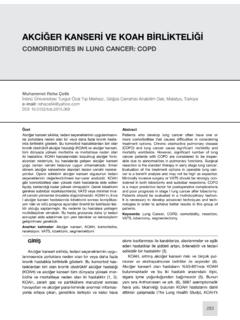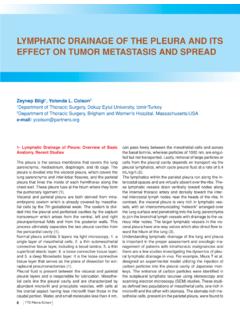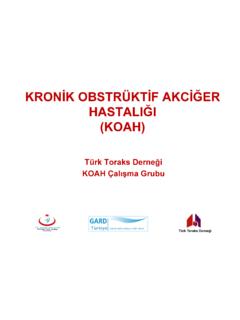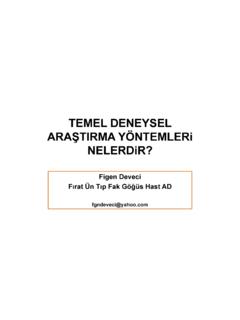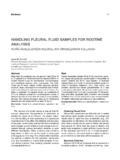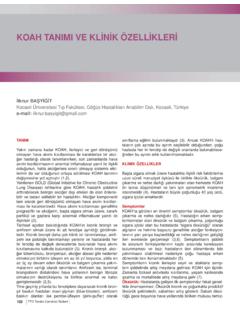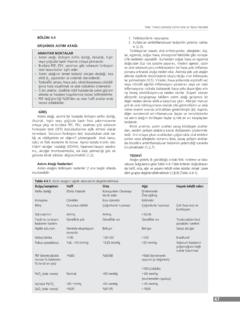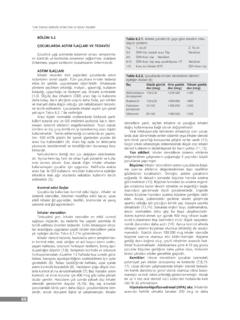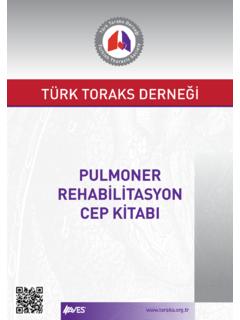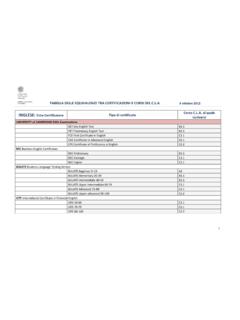Transcription of THE STORY BEHIND LIGHT’S CRITERIA - Toraks
1 THE STORY BEHIND light 'S CRITERIA . Richard W. light , Professor of Medicine Vanderbilt University Nashville, Tennessee, USA. e-mail: When I was an intern in medicine at Johns Hopkins Hospi- I submitted a proposal to the Institutional Review Board tal in Baltimore Maryland in 1968-1969, there was a period and received their approval. The blood gas machine was in where I had a large percentage of patients who had a pleu- the pulmonary function laboratory and I could measure all ral effusion. The chief resident, Dr. Richard Winterbauer, the pleural uid blood gases myself.
2 The clinical laboratory would make rounds about midnight and would always ask would measure the protein, LDH, and glucose in the se- me what the thoracentesis revealed. At that time we would rum and pleural uid without charge. However, I did have to routinely measure the cell count and differential, the glu- come up with some funds to pay for the LDH isoenzymes. cose, the protein and do smears and cultures on the pleu- I received a small grant from Johns Hopkins Hospital to ral uid. I would ask Dr. Winterbauer the signi cance of the fund this. various pleural uid ndings and for the most part he had In order to get called when patients with pleural effusions no answer.
3 It was at this time that additional measurements were were admitted, I made a deal with my fellow interns and being made on blood such as the lactic dehydrogenase residents. If they would call me when they did a thoracen- (LDH), SGOT and SGPT. At about the same time, blood tesis, I would do the cell count and differential on the pleu- gas machines became available that would allow one to ral uid. These were duties for which they would normally accurately measure the pH, PCO2, and PO2 of body uids. be responsible. I found out in a hurry that with this arrange- I theorized that some of these new measurements might ment I got called often in the middle of the night about pleu- be useful in the differential diagnosis of pleural effusion.
4 Ral effusions. After doing a literature review, I developed two hypotheses. One of the rst patients I studied was a young man with The rst was that the pH of pleural uid would be lower in an exudative lymphocytic effusion. His pleural uid pH was tuberculous pleural effusions than other exudative pleural The patient turned out to have caseating granulomas effusion. The basis for this hypothesis was an article in the on the needle biopsy of his pleura. So much for the rst Scandanavian Joural of Respiratory Disease that purport- hypothesis. Shortly thereafter another patient had a pleural ed to show this (1).
5 My second hypothesis was that LDH. uid pH of The pleural uid was clear yellow and the isoenzymes would be useful in the differential diagnosis pleural uid glucose was not reduced. However, the pleu- of exudative pleural effusions. In order to get the absolute ral uid grew Streptococoous pneumonia and the patient value of the LDH isoenzymes, I needed to have the total LDH in the pleural uid and the serum. A previous study eventually developed a frank pneumococcal empyema. on pleural uid LDH concluded that the pleural uid LDH This was the rst case suggested that a low pleural uid was elevated in malignant pleural effusions compared with pH might be an indicator of a complicated parapneumonic other pleural effusion (2).
6 Effusion (3). Cilt: 4 Say : 1 Ocak 2010 17. THE STORY BEHIND light 'S CRITERIA . Over a two year period I studied over 150 pleural effu- the paper and submitted it to the Annals of Internal Medi- sions. I submitted an abstract of my preliminary ndings to cine. There it was accepted with minimal revisions (6). the American Thoracic Society for their annual meeting in The rst reference to light 's CRITERIA that I am aware of 1971. The abstract was rejected. I was devastated. was published in 1989 (7). Since the original publication In early 1972 Johns Hopkins had a reunion for some of its in 1972, there have been many studies comparing other alumni.
7 My mentor, Dr. Wilmot C. Ball, Jr., suggested that measurements to light 's CRITERIA for the separation of tran- I present something on the pleural uids that I had been sudates and exudates, but in general light 's CRITERIA have studying. At that time transudates and exudates were usu- been proven to be better than anything else. I am amazed ally separated by using a protein level of gm/dl (4). that after 38 years light 's CRITERIA are still being used. I elected to see how this would work on my set of pleural I believe that there are several lessons to be learned from effusions.
8 On one rainy, sleety Sunday in Baltimore, Mary- my experience in developing light 's CRITERIA . First, if you land, I spent several hours with a pencil and graph paper want people to cooperate with you on your research, you plotting protein levels, LDH levels and ratios of protein and need to made it worthwhile for them. In this case, I did LDH in the serum and pleural uid. some of the work that they would otherwise have to do. When I examined my plots, it was obvious that no single Second, although research is best done when it is hypoth- value of any of these measurements correctly identi ed esis driven, it is worthwhile to look at your data to determine all transudates and exudates.
9 If the cutoff was made high if there are other interesting ndings. Third, if you initially enough so that all transudates were below the cutoff level, submit your work and it is not particularly well received, do then some exudates would be classi ed as transudates. not give up. Remember the rst abstract on light 's CRITERIA My objective at that time was to identify all exudates cor- was turned down. rectly. Therefore I elected to make the cutoff points such that no transudates were above the line. I noticed that REFERENCES. when I did this, some exudates were in the transudative range for each of the measurements However, I also no- 1.
10 Holten K: Diagnostic value of some biochemical pleural uid ticed that if you used three different cutoff levels such that examinations. Scand J Resp Dis [Suppl] 1968; 63: 121-5. no transudates were above the cutoff line, one could identi- 2. Wroblewski F, Wroblewski R: The clinical signi cant of lac- fy almost all transudates and exudates correctly. The three tic dehydrogenase activity of serous effusions. Ann Intern cufoff points that I found were a protein ratio greater than Med 1958; 48:813-22. , an LDH ratio greater than and an absolute pleural 3. light RW, MacGregor MI, Ball WC Jr, Luchsinger PC: Di- uid LDH greater than two thirds the upper normal limit agnostic signi cance of pleural uid pH and PCO2.
